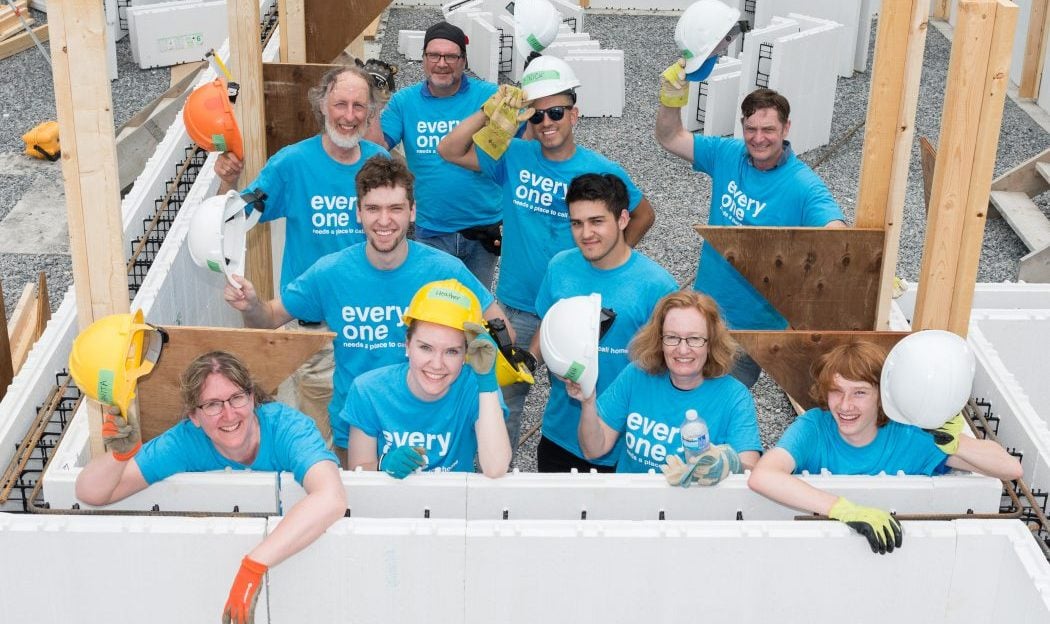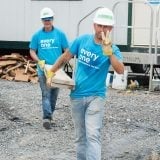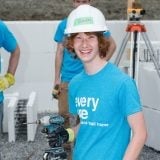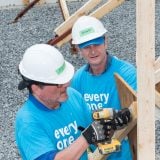It’s doubtful we’ll get snapped up by the home building industry anytime soon, but the recent Habitat for Humanity team build by All Things Home proved how much people can accomplish when their hearts are in the right place.
Our hard-working, 10-member team – everyone from real estate folks to students – took a day out of their busy schedules to work on four Habitat townhomes in Orléans. The homes, which will be ready for occupancy later this year, are part of Leacross Landing, a 16-unit build that is the most ambitious project to date by Habitat for Humanity Greater Ottawa (Habitat GO).
Like all Habitat builds, this one gives low-income, working families the opportunity to own a home. In lieu of a down payment, each family puts in 500 hours of “sweat equity” at the site or elsewhere and pays for the homes through interest-free mortgages.
As Habitat organizers are fond of saying, it’s a hand up, not a hand out.
Our mission: ICFs
Our job for Build Day was single-minded: Prepare for the imminent pouring of foundations for the second block of homes – the adjoining first block was completed but not yet occupied – by erecting Insulated Concrete Forms (ICFs). The Lego-like blocks are made of two walls of rigid insulation between which concrete is poured, creating an instant, energy-efficient structure.
The fact that ICFs were, to some of us, a complete unknown was no big deal. As team member and mortgage broker Nick Bachusky said, “I’ve always wanted to see how a home is constructed, and this is great for the community.”
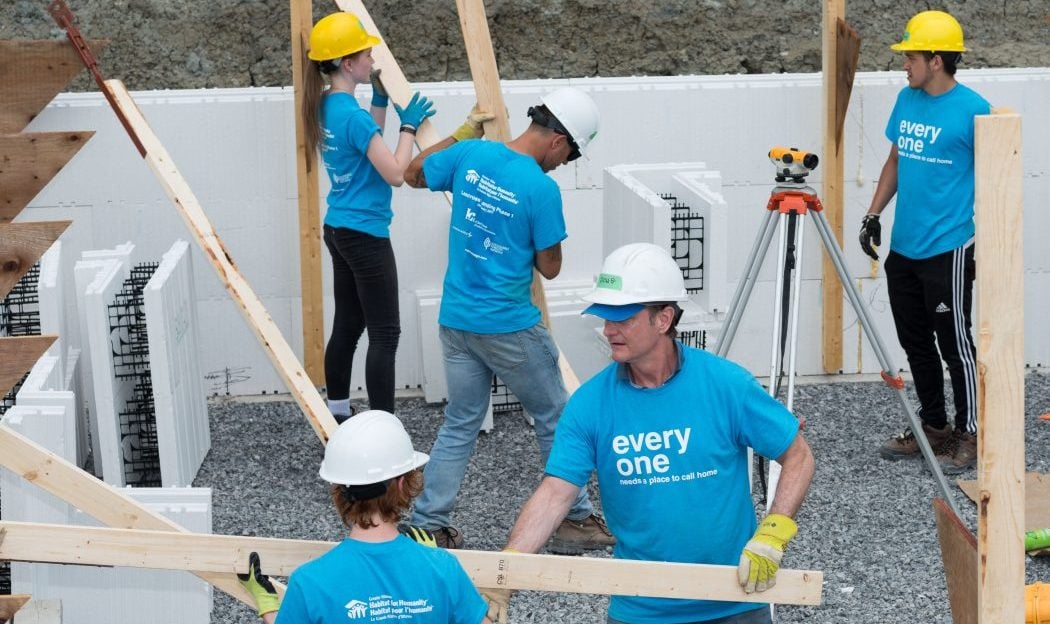
A Habitat build is all about team work.
After a brief orientation by Habitat construction manager Steve Walsh, a focused, well-tanned guy with decades of construction experience behind him, we clambered six feet down a ladder to start piecing together the ICF structure.
We were a bit like an ungainly colt at first. Enthusiastic but unused to working together, we were ill-coordinated, uncertain how to make all the parts move in unison.
That changed rapidly. We fell into a rhythm, team members pairing off to work together. Soon, we were anticipating the other person’s moves, using the verbal shorthand you’d hear on any construction site – “Looks good,” “You need screws?” “A bit higher” – and kidding each other, humour being the grease that keeps any human machine running smoothly.
You wonder why we can’t apply such a model of easy cooperation to humanity at large, but that’s a question for another day.
On-the-job training
While some of us had done home renos, construction was new to others.
“I’ve never built anything in my life. I’ve never used tools before,” said Sarah Brown, a perennially upbeat freelance writer and editor. “This is a neat confidence builder.”
Her son, Owen, who’s going into Grade 11 and said he’d signed on to the build because “it’s a great thing, helping people,” explained that he’s thinking of a career in building design or construction but hadn’t known anything about ICF. “It’s really cool and interesting to learn how you can do your foundation and insulation all at once.”
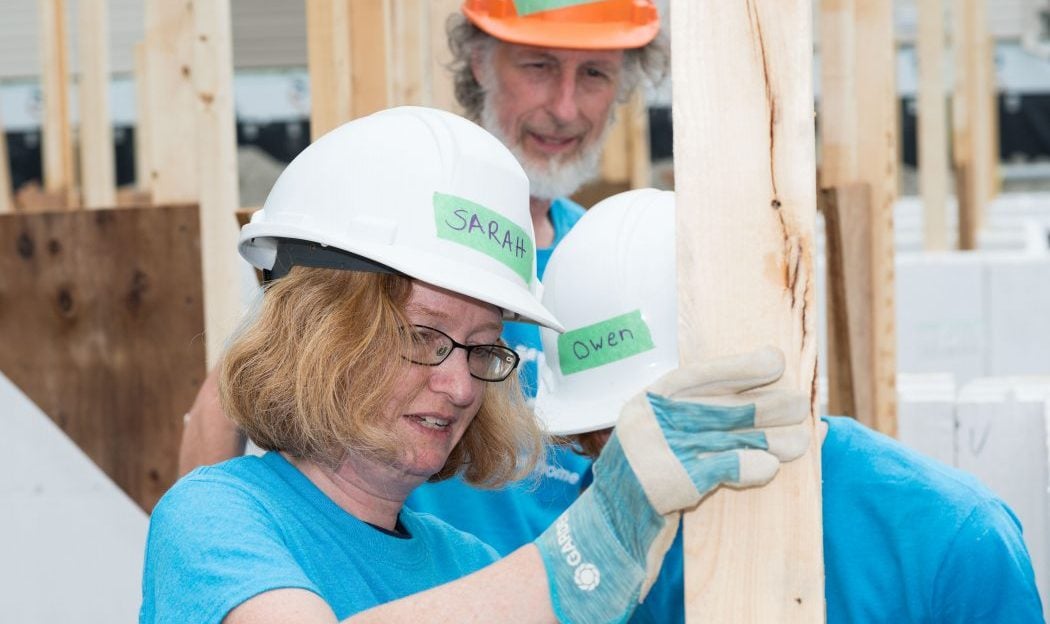
Sarah Brown learns about construction while son Owen Asselstine and Patrick Langston look on.
We also learned that a construction project, especially one manned by volunteers, has its own pace. Things zip along for awhile and then grind to a halt when an unanticipated problem – say, an uneven wall – rears its head and has to be solved by the pros like Walsh.
It’s not an unwelcome halt, particularly on a hot day when clothes cling to your body and you cheer the slightest breeze. Folks use the time to catch up on emails and texts, chew over Donald Trump’s latest blundering, mourn the shuttering of yet another community newspaper.
As you chat, you realize that even a quiet time is part of team and community building, that relationships can be fostered no matter what the setting. And when a cardinal begins singing in the trees separating the build site from the neighbouring homes, it feels almost like he’s applauding our spirit.
Stepping outside the bubble
And so the day goes.
There’s a convivial lunch break in an air-conditioned trailer, food courtesy of a local business and conversation – the shocking defeat of Germany in the FIFA World Cup, Brian Adams’ impending Bluesfest concert – served up by everyone present.
There’s more ICF construction, cutting of rebar to reinforce the concrete when it arrives, the forming of a fireman’s brigade to move scaffolding material from one section of the build to another.
- Doug Herbert & Nick Bachusky haul planks for scaffolding.
- Owen Asselstine gets ready to do some serious drilling.
- Peter Burry and Doug Herbert assemble scaffolding.
There’s also much kidding when a team member, safely ensconced in a hard hat, gets bonked on the head by a tossed water bottle that veers off-course.
And there’s joshing between Heather Burry and her boyfriend, Jinseng Vanderkloot, a third-year electrical engineering student who later says he’s on hand because “it’s important for the community. It’s a way to show your support and help people instead of just being in your bubble.”
The workday ends
By 3 p.m., we’re pretty much tuckered out and we’ve got everything in place for the next day’s crew.
Walsh calls a halt to the work, we collect our belongings at the trailer, shake hands and head home, satisfied that we’ve contributed to something bigger than ourselves.
One suspects Nick Bachusky speaks for everyone when he says, “This is my first time with Habitat, but not the last. I’d do it again – absolutely!”
Individual and team volunteers are the backbone of Habitat’s home building. Learn more here.
Related
Habitat homeowners get their keys
Habitat goes big with new Stittsville ReStore
